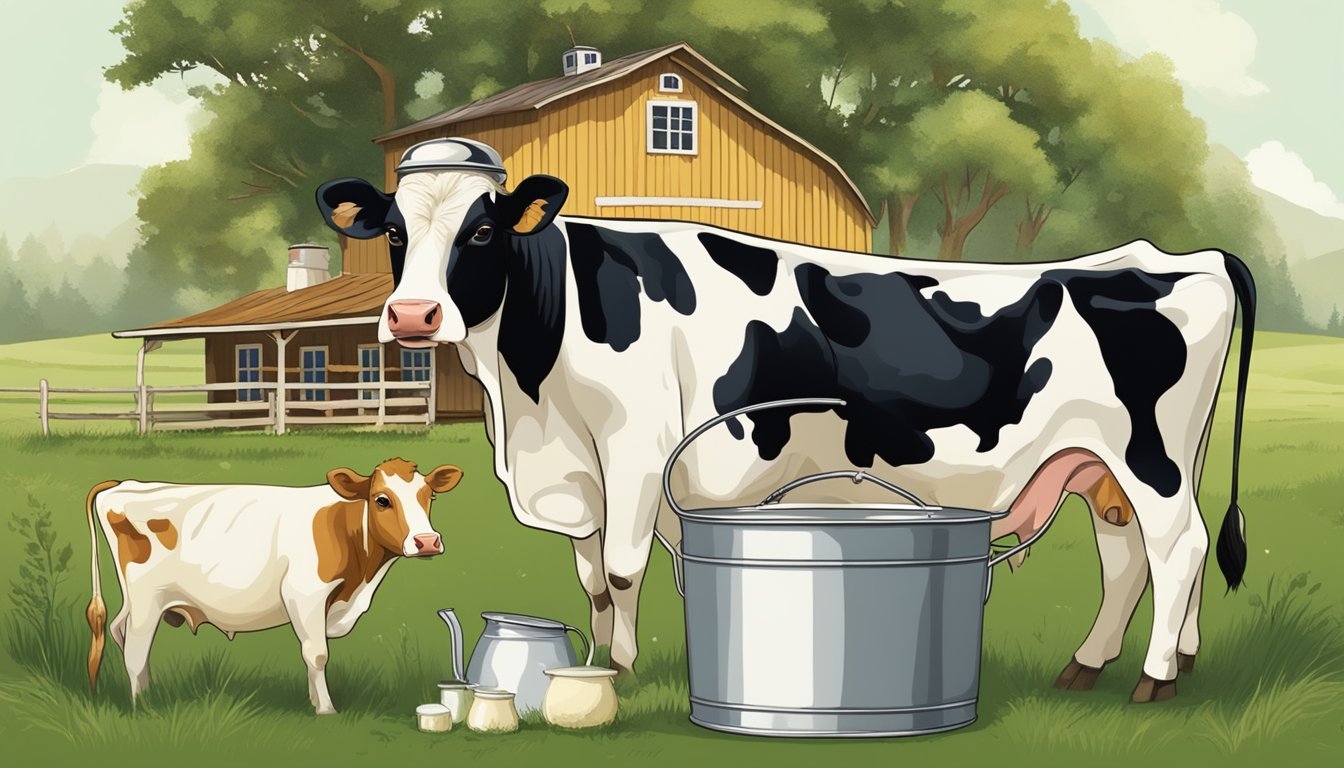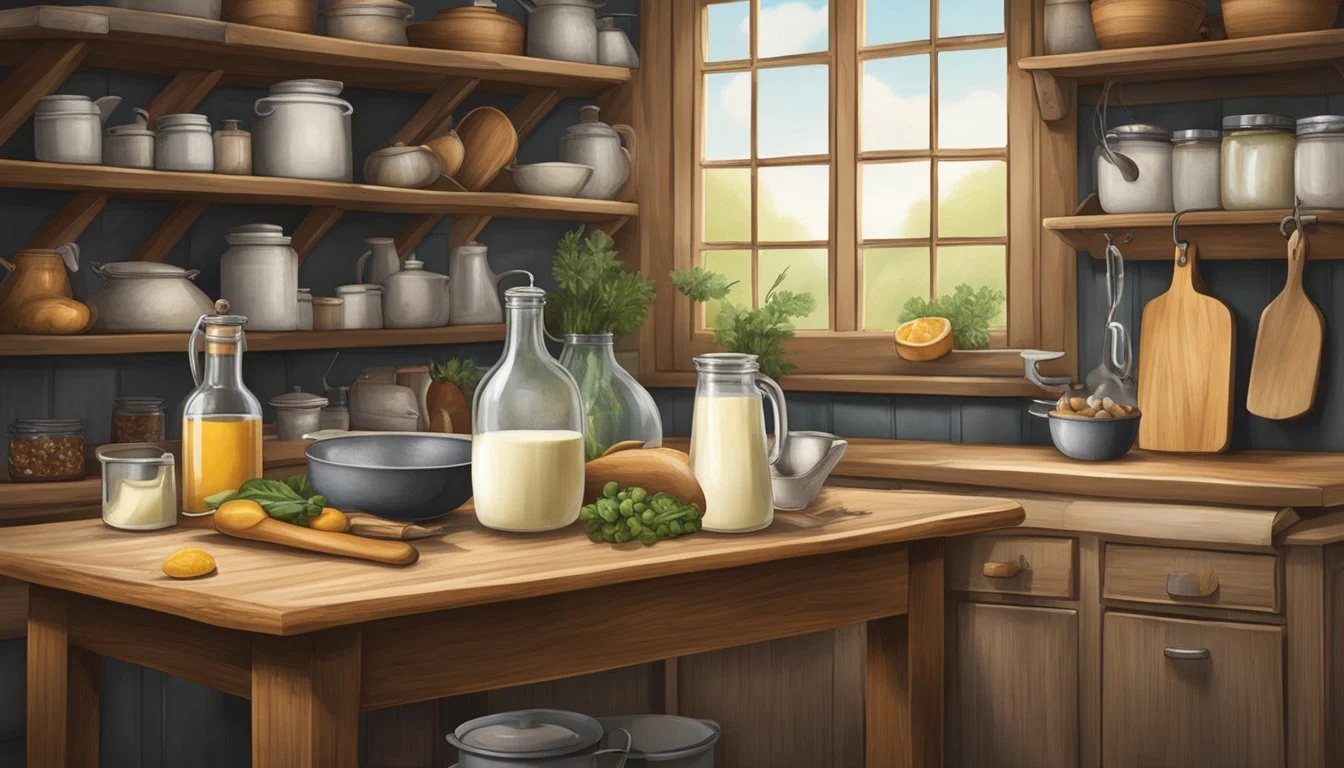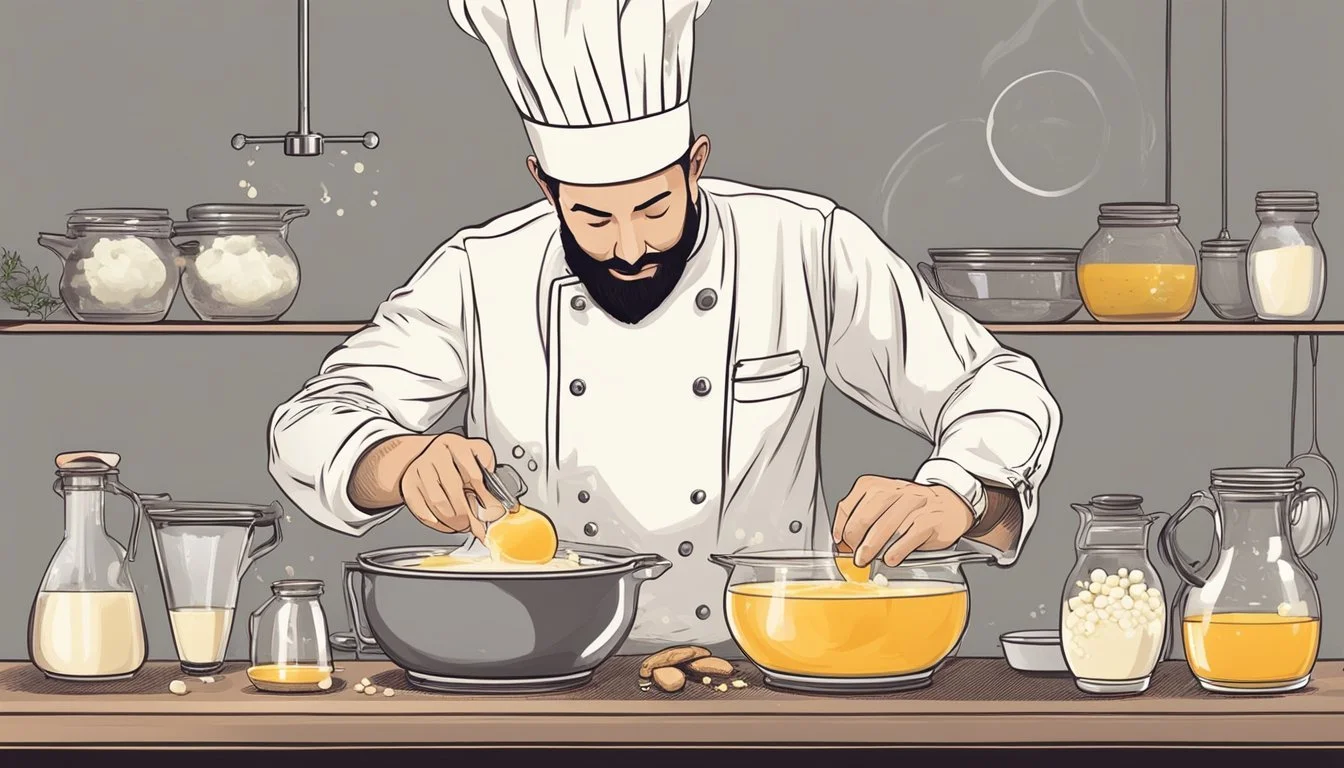Raw Milk in Gourmet Cooking
Unveiling the Choice of Culinary Masters
Raw milk, often seen as a controversial ingredient due to its unpasteurized nature, has found a distinct place in the realm of gourmet cooking. With its rich, complex flavor profile, raw milk has captured the attention of top chefs looking to elevate their culinary creations. While the usage of raw milk is regulated in many parts of the world, its unique characteristics are embraced by some for their ability to impart a depth of flavor that pasteurized milk often lacks.
Gourmet cooking is about innovation and expressing the purest essence of ingredients, and top chefs are continually searching for exceptional products that can deliver an unparalleled sensory experience. Raw milk, with its inherent creaminess and nuanced taste, offers a foundation upon which artisan cheese, yogurt, and other dairy delicacies can be crafted. These chefs advocate for the ingredient's potential, integrating it into their cuisine where legally permitted and emphasizing both its culinary benefits and the importance of sourcing from reputable, safety-conscious producers.
Raw milk has found its place in gourmet cooking, captivating the culinary world with its unique qualities and engaging in the ongoing raw vs. pasteurized milk debate. Chefs and food enthusiasts are increasingly drawn to the exceptional flavors and textures that raw milk brings to gourmet dishes, elevating the dining experience with its rich and unadulterated profile.
In addition to its culinary appeal, raw milk is also valued for its potential to contribute to bone health, adding a wholesome dimension to gourmet creations. Its inclusion in gourmet cooking has been celebrated at various culinary events and raw milk festivals, where chefs showcase the versatility and richness of raw milk in creating exquisite dishes that captivate the palate.
Moreover, the consideration of raw milk in gourmet cooking extends to its potential to promote digestive health and its historical significance in traditional medicine, adding depth and nuance to the culinary narrative. The diverse microbial world present in raw milk also adds a layer of complexity and depth of flavor to gourmet dishes, appealing to discerning palates and culinary connoisseurs. In essence, raw milk has become a prized ingredient in gourmet cooking, adding a touch of natural, unprocessed goodness to the culinary landscape.
Raw Milk Basics
In exploring the esteemed kitchens of top gourmet chefs, one intriguing ingredient often emerges: raw milk. This section delves into the essence of raw milk and its application in culinary creations.
What is Raw Milk?
Raw milk is essentially milk in its unprocessed form, directly obtained from animals such as cows, goats, or sheep. Unlike homogenized or pasteurized milk found in most grocery stores, raw milk is neither mechanically mixed to break down fat molecules nor heat-treated to kill bacteria. This results in a product that retains its original fat content and natural enzymes. It's crucial to note that while raw milk can harbor beneficial nutrients, it also posses the risk of containing harmful bacteria that pasteurization would typically eliminate.
Nutrient Content in Raw Milk:
Protein: Approximately 8 grams per cup
Carbohydrates: Roughly 12 grams per cup
Essential vitamins and minerals present
Benefits in Cooking
Chefs value raw milk for its unparalleled freshness and rich, complex flavors which can enhance a variety of dishes. The high-fat content in raw milk contributes to its creamy texture, and when used in recipes, it imparts a depth of flavor that pasteurized milk often lacks.
Culinary Uses of Raw Milk:
Sour raw milk can be used to add tanginess to baked goods and dressings.
Its cream can be churned into butter, offering a distinctive taste.
Used in cheese-making, raw milk can produce cheeses with more nuanced flavors.
In gourmet cooking, raw milk is not just an ingredient; it's a statement about tradition and taste. Chefs must carefully balance the benefits against the potential risks, ensuring that the raw milk they use is of the highest quality and handled with meticulous care.
Health and Safety Considerations
Incorporating raw milk into gourmet cooking requires an understanding of its unique characteristics and the necessity for careful attention to health and safety protocols to mitigate risks associated with harmful bacteria.
Understanding Pasteurization
Pasteurization is a process where milk is heated to a specific temperature for a set period to kill off pathogenic bacteria. This is crucial because raw milk can contain dangerous bacteria such as Salmonella, E. coli, and Listeria. While some argue that pasteurization may affect taste and nutritional content, it remains the standard for reducing the risk of foodborne illness.
Safe Handling of Raw Milk
For chefs opting to use raw milk, strict safety practices must be in place:
Temperature Control: Keep raw milk at 40°F or below to inhibit bacterial growth.
Source Verification: Obtain milk from reliable producers with high sanitary standards.
Cross-Contamination: Avoid cross-contaminating raw milk with other foods, particularly those eaten raw.
Consumer Communication: Inform consumers about the potential risks associated with consuming raw milk products.
Culinary Techniques with Raw Milk
When chefs incorporate raw milk into gourmet recipes, they unlock a trove of rich flavors and textures. This natural, unprocessed ingredient contributes to creating dishes that are both nutritionally superior and distinctly aromatic.
Incorporating Raw Milk in Recipes
Chefs use raw milk to add a unique depth to their recipes. Its high fat content is essential when the goal is to thicken sauces, soups, and stews without the artificial consistency of thickeners. Recipes like a classic béchamel rely on the milk's natural properties to achieve the desired creamy texture. Raw milk's delicate reactions to heat require a gentle approach; chefs typically warm it just enough to meld flavors without destroying beneficial enzymes.
Butter and Cream: They extract cream from raw milk to produce fresh, homemade butter, adding a velvety finish to baked goods and pastries.
Custard: With careful temperature control, raw milk is an incredible base for custard, yielding a dessert that is silky and rich.
Enhancing Flavors with Raw Milk
The subtle sweetness and creaminess of raw milk can elevate the inherent flavors of top-notch ingredients. Chefs might introduce it into a brie cheese recipe, where it imparts a complexity that pasteurized milk simply cannot match.
Sauces: It infuses sauces with a round, lush mouthfeel.
Soup: A dash in a robust soup can soften acidity and add layers of flavor.
To conclude, expert chefs effectively utilize raw milk's robust characteristics through precise cooking techniques, lending an authentic touch to gourmet dishes.
Raw Milk in Baking
In gourmet baking, the unique properties of raw milk can enhance the flavor and texture of pastries and bread. Chefs utilize its naturally occurring enzymes to create distinct baked goods.
Using Raw Milk in Pastry
When raw milk is incorporated into pastries, chefs note a remarkable improvement in the depth of flavor. The high butterfat content in raw milk contributes to a richer, more tender pastry dough. For instance, when making puff pastry, the use of raw milk can result in layers that are both flakier and more flavorful than those made with pasteurized milk.
Butter: When churning raw milk for butter, the resultant product retains more of the milk's original flavor profile, which can significantly enhance the taste of pastries.
Cheese: Cheesecakes or pastries that include cheese can benefit from raw milk, as it gives a more complex taste due to the variety and richness of naturally occurring bacteria.
Flour: Chefs recognize that pairing high-quality flour with raw milk can optimize gluten development, leading to a superior pastry texture.
Raw Milk in Bread Making
Raw milk similarly transforms bread making, as it positively affects both the fermentation process and dough conditioning. The natural sugars and enzymes in raw milk can feed the yeast more effectively, promoting a more vigorous rise and a subtly sweet note in the final bread product.
Yeast: The enzymes in raw milk can help to activate yeast more efficiently, leading to improved leavening.
Dough: Raw milk contributes to dough's elasticity and moisture retention, creating bread with a soft crumb and crust that's delicately crisp but not tough.
Bread and Baked Goods: Not only does raw milk improve the texture, but it also imparts a complexity of flavor to bread and baked goods that pasteurized milk does not match.
Desserts: Many desserts that include dairy as a pivotal ingredient, such as custard-based desserts, can gain a more nuanced flavor from raw milk.
By harnessing the attributes of raw milk, bakers can produce pastries and bread that stand out for their enhanced texture and exceptional taste.
Raw Milk as a Secret Ingredient
Top chefs often employ raw milk in their kitchens due to its richer flavor profile and the unparalleled creaminess it adds to various gourmet dishes.
Dishes Transformed by Raw Milk
Pastries and Desserts: In the realm of sweet indulgences, raw milk singularly elevates pastries, from flaky croissants to decadent mousses. Chefs incorporate it into their recipes to enhance the natural flavors of the ingredients, often finding the texture of their desserts becomes more luscious and their taste more nuanced.
Chocolate Milk: By blending raw milk with heated water and quality cacao, a delicious, creamy chocolate milk is crafted, offering a superior taste over conventional options.
Sauces and Creams: Raw milk serves as the foundation for velvety sauces and creams, crafting a richer gastronomic experience. Savory dishes are given an opulent touch, whether it’s a raw milk béchamel sauce for pasta or a stroke of raw cream over roasted vegetables.
Raw Milk in Global Cuisines
Globally, raw milk's versatility shines across a multitude of traditional and contemporary cuisines. In European countries, raw milk forms the basis of countless artisan cheeses, each with its unique flavor and texture—sought after by cheese connoisseurs and casual fans alike.
Indian Cuisine: In India, raw milk is integral to the making of Paneer, a fresh cheese staple in many vegetarian dishes (What wine goes well with vegetarian dishes?), adding a hearty consistency to meals like saag paneer.
French Cuisine: French chefs have long celebrated raw milk for its quality, using it to produce a variety of cheeses and creams that are pivotal in traditional French cooking. It infuses a certain je ne sais quoi into both rustic and refined dishes, such as potato gratin and creamy vegetable soups.
Sourcing and Selection
In gourmet cooking, sourcing the highest quality ingredients is essential for the best outcome. Raw milk, with its rich flavor profile, is a sought-after commodity among top chefs. The process of selection and acquisition plays a critical role in ensuring the milk's contribution to culinary excellence.
Choosing High-Quality Raw Milk
Key Criteria for Assessment:
Freshness: Chefs should ascertain the milk's harvesting date. Fresher milk equates to better flavor and nutritional value.
Fat Content: Higher fat content in cow's milk or goat's milk can enhance the richness and texture of dishes.
Health Standards: Milk should be sourced from farms adhering to strict health and safety protocols, ensuring it is safe for consumption.
Storage and Treatment:
Temperature: Milk must be stored at the correct temperature, just above freezing, to maintain its quality.
Treatment: While raw, it must not be pasteurized or homogenized, retaining its distinctive taste.
Local Farms and Dairy
Local farms often provide superior options for raw milk due to the reduced time between milking and delivery. Relationships with local dairy farmers can afford chefs deeper insight into production methods and animal welfare practices.
Factors to Consider:
Proximity: Local farms offer shorter supply chains, meaning reduced transport time and fresher milk.
Herd Health: The health of the cows or goats directly influences milk quality; thus, chefs may visit farms to verify conditions.
Sustainable Practices: Many chefs prefer sourcing from farms employing sustainable practices to support the environment and local economy.
Connecting with the Source:
Chefs, such as cookery writers and restaurant owners, often collaborate closely with farmers, sharing knowledge and creating a transparent food journey for their patrons.
Certifications:
Farms with organic or biodynamic certifications give an extra level of assurance about the milk's purity and the farm's commitment to quality.
Raw Milk in Specialty Dishes
Within gourmet cooking, raw milk distinguishes itself by enriching specialty dishes with its unaltered, flavorful profile. Top chefs utilize raw milk to craft creamy sauces (What wine goes well with creamy sauces?) and dressings and to add a depth of flavor to dairy desserts.
Creamy Sauces and Dressings
Raw milk serves as a foundational ingredient for creating rich, creamy sauces and dressings that enhance a variety of gourmet dishes. When chefs incorporate raw milk into sauces, such as a classic béchamel or a smooth tomato cream sauce, they utilize its full-bodied taste and velvety texture. For dressings, the natural thickness of raw milk—often in the form of kefir or sour cream—provides a luxurious base that clings to salads or serves as a dip for crudité.
Creamy Tomato Sauce: Chefs often use raw milk instead of cream to impart a subtle richness that does not overpower the fresh taste of tomatoes.
Kefir Dressings: Fermented from raw milk, kefir adds both tanginess and probiotics to dressings, fostering a complex flavor profile.
Exquisite Dairy Desserts
Raw milk's unprocessed quality is particularly prized in the domain of desserts, where its full flavor contributes to exquisite culinary creations. It plays a central role in crafting homemade ice cream with a custardy texture and robust taste, distinguishing it from those made with pasteurized milk. Desserts such as panna cotta, milkshakes, and silky yogurts also benefit from the creamy layer raw milk imparts, giving them a distinct gourmet twist.
Vanilla Bean Ice Cream: Utilizing raw milk and double cream ensures a rich and creamy texture; the untreated milk also helps carry the delicate aroma of vanilla beans throughout the dessert.
Seasonal Fruit Milkshakes: The ripe flavors of seasonal fruits are elevated when blended with raw milk, resulting in milkshakes that are both refreshing and creamy.
By infusing sauces, dressings, and desserts with the nuanced flavors of raw milk, chefs achieve unparalleled tastes and textures in their gourmet dishes.
Pairing Raw Milk with Ingredients
In gourmet cooking, the subtle nuances of raw milk can be enhanced with the right combination of spices and balancing flavors. This section explores how to skillfully incorporate raw milk with specific ingredients to elevate culinary creations.
Complementing Raw Milk with Spices
Pairing spices with raw milk requires a careful balance to enhance its natural sweetness and creaminess.
Cinnamon: A pinch of cinnamon can bring a comforting warmth to raw milk-based beverages and desserts, complementing its rich texture.
Turmeric: Known for its earthy undertones and health benefits, turmeric pairs well with raw milk to create soothing golden milk lattes.
Fenugreek: This aromatic spice offers a subtle hint of maple, which complements the natural sweetness of raw milk in baked goods and sauces.
Key Spices to Pair with Raw Milk:
Spice Pairing Suggestion Cinnamon Sprinkle in warm milk drinks or custard preparations Turmeric Stir into raw milk lattes or smoothies Fenugreek Incorporate into spice blends for creamy sauces
Balancing Flavors
Achieving the perfect balance of flavors with raw milk involves the interplay of seasoning and acidity.
Salt: A touch of salt can intensify the milk's inherent flavors, making it an ideal addition to raw milk cheeses and butters.
Lemon Juice: The acidity of lemon juice cuts through the richness of raw milk, providing a fresh lift in sauces and dressings.
Garlic and Olive Oil: When creating savory dishes, the combination of garlic and olive oil with raw milk enhances its natural depth, ideal for creamy pasta dishes or risottos.
Ingredients for Balanced Raw Milk Flavors:
Savory:
Garlic (crushed)
Olive oil (extra virgin)
Acidic:
Lemon juice (freshly squeezed)
Seasoning:
Salt (fine)
Pepper (freshly ground)
In sauces or dressings, chefs may start with a base of raw milk, whisk in olive oil, add garlic for depth, and finish with a squeeze of lemon to brighten the flavors. Fresh herbs like thyme and sage can also be tied in for an aromatic touch and additional layer of sophistication.
Raw Milk in Vegan Cooking
In the landscape of gourmet vegan cooking, raw plant-based milks have become indispensable. Chefs often opt for almond milk or coconut milk due to their rich textures and versatility in an array of dishes. These milks are heralded not only for their nutritional profile but also for their ability to mimic the mouthfeel of dairy milk.
Almond milk is prepared by blending soaked almonds with water and then straining the mixture to obtain a creamy liquid. This milk pairs well with dishes that require a subtler flavor, allowing the primary ingredients to shine. On the other hand, coconut milk, known for its thick consistency and rich flavor, becomes the star ingredient in many dishes, including soups and sauces.
Substitutes and Pairings:
Tahini: When a recipe demands a nuttier, more sesame-driven taste
Soy Sauce: To add umami depth without overshadowing delicate flavors
Chefs often incorporate these plant-based milks into their culinary creations for both their functional properties and health benefits. They can even be used in conjunction with other vegan staples, such as tahini, to produce dishes with complex layers of flavor. Although not a milk substitute, soy sauce is occasionally added to deepen the umami profile in savory vegan cuisine.
In sum, gourmet vegan cooking leverages the distinct qualities of almond and coconut milk to elevate vegan dishes to new heights. The culinary applications are vast, ranging from baking to crafting creamy sauces, showcasing their significant role in high-end vegan gastronomy.
Expert Insights and Tips
In the culinary world, raw milk is often regarded as a versatile ingredient that can elevate a dish with its richness and depth of flavor. Renowned chefs and food writers have shared their insights on how to use raw milk to its fullest potential.
Chef's Secrets for Using Raw Milk
Texture and Flavor: Chefs appreciate raw milk for its superior creaminess and complex flavor profile, which can vary depending on the diet and breed of the cow. For example, Bridget Lancaster, a chef and cookery writer, emphasizes the importance of using high-quality raw milk for making rich, velvety sauces and creamy desserts. (What wine goes well with creamy desserts?) When using raw milk, temperature control is crucial; it should be gently heated to avoid curdling and to maintain its nutritional benefits.
Cheese Making: Many chef-owners swear by raw milk for crafting artisanal cheeses. A slow and low heat process allows for a fuller development of taste and texture in cheeses compared to those made with pasteurized milk. Chefs caution that raw milk must be sourced from reputable farms to ensure safety and quality.
Food Writers on Raw Milk
Health and Taste: Food writers often hail raw milk for its health benefits, including a higher content of beneficial enzymes and bacteria. However, authors also note that it's imperative to obtain raw milk from certified sources to mitigate any health risks. They advocate for its use in gourmet cooking, pointing out that the nuanced flavors of raw milk can greatly enhance the taste of baked goods and other recipes.
Regulatory Consideration: Cookery authors also touch upon the legal aspects of raw milk usage, highlighting that it is subject to stringent regulations and not available everywhere. They advise home cooks to be well-informed about the laws in their region before incorporating raw milk into their cooking.
Worldwide Raw Milk Use
Raw milk has a profound heritage around the world and continues to be an integral part of both traditional and contemporary culinary practices. Its versatility and rich flavor make it a cherished ingredient in kitchens across the globe.
Raw Milk in Traditional Cuisine
In traditional cuisines, raw milk and its derivatives are staples. In India, raw milk is used to prepare butter chicken, a dish where the meat is marinated in a creamy mixture before being cooked in a spiced tomato sauce. European culinary traditions often use raw milk to create delicate sauces or to enhance the richness of lamb dishes. Kolkata is famed for its street food, where raw milk is a key ingredient in a variety of sweets that hold a special place in the local gastronomy.
Contemporary Uses Across the Globe
Today, chefs around the world incorporate raw milk into modern dishes to add a touch of gourmet luxury. A popular use of raw milk is in the crafting of artisanal butter, which lends a unique flavor to any recipe. The versatility of raw milk makes it a favorite among gourmet chefs, who use it to create a fusion of flavors by combining it with ingredients like the citrusy yuzu to create innovative, modern dishes. As a condiment, raw milk can be transformed into a sour cream or crème fraîche, complementing contemporary takes on both high-end and street food dishes.
Creative Dairy Infusions
Incorporating raw milk into gourmet cooking allows chefs to introduce unique textures and flavors. Through creative dairy infusions, top chefs elevate traditional dishes and beverages, using the rich profile of raw milk as a foundation.
Cocktails and Beverages
Raw milk offers a luxurious creaminess to classic cocktails and novel beverages. A Milk Bar can provide a variety of milk-based drinks, from sophisticated milk punches to innovative milkshakes. Chefs often combine raw milk with white wine to create a light yet creamy concoction. For an elegant touch, one can infuse milk with botanicals such as lavender or vanilla, then blend it into a silky milkshake that surprises the palate.
Milk Punch: Infuse raw milk with citrus peels and spices, then clarify it for a smooth texture.
Wine & Milk: Blend white wine with infused raw milk for a nuanced beverage.
Innovative Dairy Snacks
Chefs use raw milk to craft innovative dairy-centric snacks that are both comforting and gourmet. A twist on macaroni and cheese, for instance, can feature raw milk infused with sun-dried tomatoes for a tangy, creamy sauce. Snacks like cheese sticks or dairy dips gain complexity from raw milk that has been steeped with herbs or edible flowers.
Infused Macaroni: Raw milk and sun-dried tomatoes create an indulgent, tangy sauce.
Herb-Steeped Dairy Dips: Enhance cheese dips by steeping raw milk with rosemary or thyme.
Tools and Equipment
When cooking with raw milk, chefs rely on a collection of essential tools and high-quality equipment designed for precise dairy preparation. This set of tools ensures that the unique properties of raw milk are preserved and that its full potential is harnessed in gourmet dishes.
Essentials for Cooking with Raw Milk
Pot: A heavy-bottomed pot is critical for gently heating raw milk without scorching. Stainless steel is preferred for its even heat distribution and non-reactive properties.
Thermometer: Precise temperature control is paramount. A digital or analog thermometer is a chef's best friend to monitor the milk's temperature accurately.
Whisk: To prevent the formation of milk skin and incorporate even heat, a wire whisk is essential for stirring raw milk as it heats.
Strainer: A fine-mesh strainer is used to remove any impurities from the milk after heating, ensuring a smooth consistency.
Measuring Tools: Accurate measuring cups and spoons are essential for maintaining the correct ratios of milk to other ingredients, such as starch, to achieve desired textures.
Specialty Tools for Dairy Preparation
Cheesecloth: For making cheese or straining milk solids, cheesecloth is indispensable. It removes whey and allows for the creation of various dairy products.
Dairy Thermometer: A specialized dairy thermometer may be necessary for cheesemaking, providing more detail at the temperature ranges relevant to dairy processing.
pH Meter: Advanced dairy preparation might require a pH meter to ensure the milk is at the proper acidity level for products like cheese and yogurt.
Curd Cutter: When preparing cheese, a curd cutter helps in creating even pieces of curd for more consistent aging and texture.
Rennet: Although not a tool, rennet is an essential ingredient for cheesemaking, crucial for coagulating the milk.
Utilizing these tools, chefs can enhance the natural flavors of raw milk, elevating their gourmet dishes with its rich and versatile taste profile. Tools like pots and thermometers ensure safe cooking practices, while specialized equipment like curd cutters and cheesecloth assist in transforming raw milk into an array of sophisticated dairy products.
Fine Dining and Raw Milk
In the realm of fine dining, the subtleties in flavor matter enormously. Raw milk, with its full-bodied taste and natural complexity, is a distinguished ingredient that top chefs prize. Unlike pasteurized milk, which has been heated to eliminate bacteria, raw milk retains a depth of flavor that enhances the culinary experience in high-end cuisine.
Chef-owners and head chefs in premium restaurants often incorporate raw milk into their recipes due to its fresh, grassy notes that reflect the terroir. When a dish requires a certain creaminess or a rich profile, raw milk can impart qualities pasteurized versions may lack. It may star in desserts, where the ingredient's inherent sweetness is pivotal in balancing flavors.
Table 1: Utilization of Raw Milk in Gourmet Dishes
Dish Component Role of Raw Milk Cream-based sauces Adds depth and creaminess Cheese in fine dining Enhances complexity and texture Gourmet ice cream Provides superior richness Desserts (e.g., panna cotta) Infuses delicate flavor notes
Furthermore, artisan cheeses crafted from raw milk are sought after for their unique character – each batch differs slightly, which can signify exclusivity in fine dining settings. They might serve as an element within a dish or as the focus of a chef's cheese course.
Even in its simplest form, raw milk may be offered as a dip alongside baked goods or transformed into cultured butter, a staple that speaks volumes of a restaurant's commitment to quality.
Understanding the risks associated with raw milk, fine dining establishments ensure they source from reputable, regulated farms. The goal is safety alongside gastronomic delight. Such meticulousness allows diners to savor the subtle, intrinsic flavors raw milk offers, giving a nod to traditional cooking methods and the authenticity respected by gastronomes.









